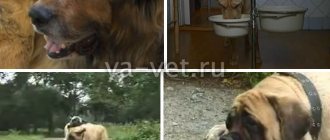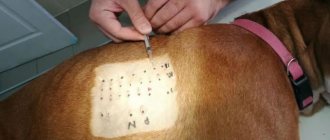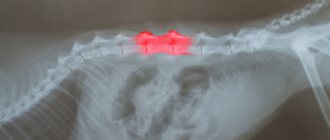Dogs of decorative breeds are active, playful and funny. The Chihuahua, Yorkshire Terrier, Spitz, Miniature Poodle, and Pekingese are especially endearing. But it is these babies who are most susceptible to such a pathology as patella dislocation. To understand what this obscure term means, what a patella is and why a dog can dislocate it, you need to understand a little about your pet’s anatomy.
Anatomical structure of the knee joint
The patella in dogs is a movable bone in the knee joint of the hind limbs, which is supported by ligaments. It is located deep within the tendon and prevents it from rubbing against the surface of the femur. The patella has a protrusion at the lower back, which protects the surfaces of the bones that form the knee joint from lateral displacement.
The kneecap is initially only able to move up and down along projections called condyles. They are a kind of guides and are located on the lower, distal end of the femur. The protrusion that is closer to the inner edge of the joint is called the medial condyle. Located near the outer edge is the lateral condyle.
When a dislocation occurs, the surfaces of the joint move relative to each other. In this case, the ligaments and the integrity of the joint capsule are damaged. Displacement of the kneecap is called patella luxation.
If the patella moves to the inside of the joint, closer to its middle, then this pathology is called medial dislocation. It is diagnosed in 80% of cases.
Mechanism of disease
The disease affects the hind limbs of the animal.
In the process of flexion and extension of the paw, 3 elements are involved: the quadriceps muscle, the calyx and the tendon. When the tendons weaken under the influence of injuries, congenital pathologies, or age, the cup does not stay in the joint capsule and comes out.
If an animal has a thin groove on the articular surface, the flat head of the bone slides up along it and does not fall into place, because of this the animal cannot bend its paw.
Symptoms of the disease and its severity
Medial luxation of the patella has the main early sign - intermittently occurring and disappearing lameness in the dog.
With patella dislocation and joint damage in dogs, their symptoms increase and progress as the disease progresses. In veterinary medicine, there is a special classification that evaluates the degree of displacement and deformation of the hind limbs.
Depending on the severity, the following stages of the disease are distinguished:
- The first stage of the disease does not yet bring the dog noticeable discomfort and pain. The bone moves from its correct location when the animal is in a relaxed state, for example, during sleep. When the dog tries to stand up, the patella does not immediately get into the desired position. The dog can straighten the joint on its own by extending its paw. The short-term lameness that occurs, followed by a normal gait, is characteristic of the first stage of the disease. At this stage of the disease, spontaneous displacement of the patella during movement practically does not occur.
- The second stage is characterized by frequent displacement of the patella. The patella can no longer return to its place on its own. At this stage, the cartilage tissue is already worn away, and inflammation occurs in the joint.
- At the third stage of the disease, the patella is constantly in a displaced state, the hip bone is turned out almost 50 degrees. When the bone is set, it stays slightly in the anatomically correct place. The injured limb may be half-bent; the dog almost does not step on it.
- In the fourth, most severe degree of the disease, the kneecap can no longer be reduced. The hip bone is turned 90 degrees, the dog cannot step on the affected leg. If both hind legs are affected, the dog loses the ability to move.
As each stage of the disease progresses, more and more damage occurs to the knee cartilage. Its elasticity decreases and there is a risk of osteoarthritis. The inflammatory process progresses, accompanied by pain.
Stages of development
A specially developed classification helps to assess the severity of damage.
I degree
The patella periodically moves spontaneously, even if the dog's limb is relaxed. Often it also returns to its place on its own. This either does not introduce any changes in the movement of the animal, or causes slight lameness. The dog holds his paw suspended for a short time, after which he leans on it again.
Read 10 symptoms of allergies in dogs and effective ways to treat the disease
At this stage, in an extended position of the paw, the patella in the medial direction can be pulled out of the joint with your fingers, and it independently returns to its place in the knee block. There is no crunching sound during manipulation. In some cases, the problem goes away with age if the disorder is caused by ligament weakness. No surgery required.
Stage II
The displacement occurs more often than usual, the dog periodically does not rely on the limb. The toes are turned inward. With bilateral damage, the dog rests on its paw, but tries not to straighten it in any way. When the kneecap is adjusted, friction occurs against the ridges of the bone, and a distinct crunching sound is heard.
In the medial direction, with the limb in an extended position, the patella can be pulled out of the joint with your fingers, but it does not return to its place. When straightening, the crest of the tibia rotates inward, and rotational instability of the joint reaches 30°. If the disorder is bilateral, the load is transferred to the forelimbs.
If there is a threat of developing osteoarthritis and if the dog is limping, it makes sense to correct the situation surgically.
Stage III
The kneecap is permanently displaced. The rotation of the hip bone and the deviation of its crest from the axis can reach 50°. The knee block is flat and there may be a tear or sprain of the anterior cruciate ligament. With a bilateral violation, the dog moves on half-bent legs in short steps. If it is unilateral, most of the time he simply does not rely on the limb.
The patella moves easily from the knee block. It is quite difficult to correct a medial dislocation at this stage, but after that it happens again. The situation requires surgical intervention.
IV stage
It is not possible to straighten the patella; it is constantly in a displaced state. The crest of the tibia is rotated 60° or even 90°. On palpation, the patella is easy to detect just above the hip joint on the inside of the thigh. The patella groove bulges, filled with bone tissue, or is empty. The dog moves in leaps and bounds or on bent limbs.
The operation does not guarantee a positive result and is only relevant for children under 1 year of age, while the bone tissue of the joints is still capable of regeneration.
Risk factors depending on age and breed
There are a number of factors predisposing to dislocation:
- hip dysplasia;
- deviation of their angle of inclination;
- congenital bone growth disorders;
- weak muscles or ligaments.
In small breed dogs, an insufficiently developed groove between the condyles of the knee joint most often provokes a dislocation of the patella. This feature is inherited genetically.
This pathology also occurs in other dog breeds: large St. Bernards, retrievers, bull terriers, and German shepherds. Other possible causes for joint deformation include:
- large body weight and excessive loads;
- limb injury and ligament rupture;
- wear of the condyles;
- weak ligaments with x-shaped position of the hind legs. In this case, lateral dislocation occurs more often.
In puppies, signs of the disease can be detected literally with their first steps. The severity of the dislocation is often assessed immediately as third or fourth.
Conversely, mild degrees of dislocation may be present in older dogs due to overuse injuries or wear and tear on the stifle joint.
Which dogs are at risk?
Patella is considered a hereditary disease characteristic of ornamental animals.
During breeding, representatives of the following breeds are tested for this disease:
- Pomeranian Spitz;
- cocker spaniel (almost all varieties);
- Yorkshire Terrier;
- Japanese Chin;
- chow-chow;
- Shar Pei;
- beagle;
- Tibetan Terrier;
- Labrador Retriever;
- Parson Russell Terrier.
Of the large dogs, Newfoundlands, Mastiffs, and Mountain Dogs suffer more often than others from dislocation of the knee joint. Small Chihuahuas and Toy Terriers can injure their paws even when jumping from chairs or sofas, which can later lead to complications such as patella.
Establishing diagnosis
If your dog is lame from time to time or constantly present, your veterinarian will first check the patella luxation. It includes:
- visual inspection, which gives an idea of how correctly the dog places its hind legs;
- palpating the joint, determining the presence of swelling, checking its location;
- determining the severity of the dislocation. To do this, an X-ray is taken not only of the knee, but also of the hip joint. An X-ray in a direct projection will allow you to see the deviation of the bone in one direction or another.
Diagnostics
To determine an accurate diagnosis and assess the severity of luxation, a specialist must:
- See the most complete clinical picture. To do this, the owner needs to take the dog on a leash and walk with it in a straight line and in a circle.
- Perform a series of orthopedic tests: anterior drawer syndrome, compression test, tenderness test and Ortolani sign (hip assessment) and determine the stage of dislocation.
- Take an x-ray with frontal and lateral projection.
Taken together, such an examination helps to most accurately detect patella luxation and differentiate the diagnosis from a possible rupture of the anterior cruciate ligament, Legg-Perthes disease, and problems with the hip or knee joint.
Drug treatment
The disease is treated depending on its severity, as well as the dog’s age and health condition.
If a dog's kneecap dislocation has not worsened beyond the first stage, then treatment can be carried out with medications.
They act like:
- painkillers;
- anti-inflammatory;
- chondroprotective.
Glycosaminoglycan drugs are medicines for humans, but they also help animals well. They contain components that are found in cartilage. If there is damage to the joints, then these medications:
- deliver the necessary substances to the damaged area;
- strengthen cartilage;
- relieve inflammation;
- restore elasticity.
Methods such as manual therapy and acupuncture have proven themselves quite well.
If a dog has a predisposition to joint dislocations, then all such procedures should begin from puppyhood. This way it will be possible to minimize the manifestations of the disease.
How is the patella test performed?
The test for patella in dogs of small breeds is carried out at the age of 6-8 months, and in representatives of large breeds - no earlier than 12-14 months after the birth of the puppy. The procedure itself is absolutely painless for the pet and does not require the use of anesthesia, because the doctor simply feels the knee joint, determines the position of the cup and enters the data of his observation into a special international certificate (Patella examination). During the examination, the dog’s gait is also assessed, and if the veterinarian has any doubts about the animal’s health, he may also prescribe an x-ray. For testing, the breeder needs to provide the specialist with the animal itself, its pedigree card, puppy card, and veterinary passport.
Find out why your dog has poor coordination and what needs to be done.
Surgical correction
The reasons for the development of the disease, the age of the dog, and the state of its health determine exactly how surgical care will be provided.
However, favorable prognosis can be expected only if the operation was performed at the second or third stage of the disease. The fourth stage cannot be corrected.
Methods of surgical correction depending on age and cause of dislocation:
- If lameness appears in a young growing dog, then surgery is necessary to avoid severe skeletal deformation. In the first year of life, the surfaces of the articular bones are still capable of regeneration; success from surgery in this case is more possible. At this age, it is advisable to perform chondroplasty. In this case, areas of cartilage that are least subject to physical stress are used as implants.
- If the notch in the knee joint is not deep enough and the articular bone is poorly fixed, trochleoplasty is performed. This is the deepening of the groove of the femur where the patella is located. To do this, a section of cancellous bone is cut out in the form of a wedge.
- To limit the rotation of the knee joint, it is stabilized by drilling channels in the tibia, applying and tightening a non-absorbable thread.
- If the joint capsule is overstretched, it is reduced by cutting out a flap.
- When ligaments are torn, they are sutured.
- In case of severe deformity and the impossibility of joint plastic surgery, an artificial fracture of the limb is performed - osteotomy. The fragments are fixed in an anatomically correct position.
The post-operative recovery period is long and difficult for the dog. She should not be allowed to put any weight on her operated paw for several weeks or even months.
After surgical treatment, cases of recurrence of joint dislocations are quite possible. To minimize risks, keep the joint mobile, and avoid muscle atrophy, the dog needs to be provided with proper nutrition, good care, and physiotherapy.
Patella in a dog: possible causes
Now let's look at what patella is in dogs. To begin with, it should be mentioned that patella, in other words, dislocation of the knee joint in an animal, is in fact an extremely common ailment
.
They can happen for a number of reasons, including: 1 The first reason is, of course, a hereditary factor. This is how we can explain the moment that the puppy or an adult was not injured anywhere. But the dislocation still happened. Predisposition to this disease begins to manifest itself at the age of four months, when the animal is just learning to walk. In order to avoid the repetition of such harmful heredity in future generations of animals, dogs with such a risk factor are simply not allowed to be mated further. The second most common cause of patella is various types of injuries: the dog could not have successfully jumped or had a fight with another dog. The third reason is the age of the animal. We all know that with age, changes occur in the body of both humans and animals, especially when it comes to bones, ligaments weaken, which is why dislocation occurs.
Why is it so important to start early treatment of patella disease in dogs?
Animal owners actually quite often encounter a similar problem with their pets. Also, the disease is dangerous, as it leads to real and serious problems regarding the functioning of the animal’s musculoskeletal system. It is best to begin treating all ailments, as well as patella in dogs, when the animal’s condition is not yet severe. Because if you start treating the symptoms of the disease at later stages, this will bring even greater inconvenience to the life of the sick dog. If the owner of the animal manages to seek help from a veterinarian at the very beginning, the animal will be able to avoid many troubles. This warning especially applies to those animal owners who have small, decorative dogs, because they are the ones who are most often susceptible to patella disease than dogs of larger breeds. Therefore, increased attention to the state of physical health should be paid to: Spitz, Chuhihuahua.
Another important fact is that patella is most often found in females; the risk of the disease increases significantly during the animal’s heat. Why? The answer is simple: during the period of heat, the dog’s hormonal levels throughout the body increase, so the joints themselves become softer at this moment.
Prevention measures
Since this disease is congenital and inherited genetically, breeding a dog with a similar problem is undesirable. The mechanism of its inheritance is not fully understood.
If the dog has a predisposition, the patella is located in the wrong place, the likelihood of dislocation is very high. It is necessary to monitor heavy physical activity and, if possible, limit it to avoid injury.
Walking to strengthen muscles will be more beneficial. Strong muscles are better able to fix the patella in the correct position.
If your dog is overweight, it puts additional stress on the joint. It is worth changing the dog’s diet, putting it on a special diet.
What it is?
This pathology is also called “floating patellas.” In general, “patella” is the kneecap, and the disease described in the article is its displacement. You can imagine how unpleasant this disease is...
Very often, a sick dog does not show any clinical signs... Until a certain point. One day she instantly becomes lame, tucks her hind limb to her stomach (pictured), squeals and whines. Just as suddenly, your pet starts running and jumping around you again, as if nothing had ever happened. If something similar has ever happened to your dog, do not delude yourself about his sudden “recovery”: the patella, once manifested, will remind itself regularly.
What to do?
Firstly, at the slightest sign similar to those described by us, you need to put your dog on a diet (if he is overweight). Secondly, no matter how strange it may seem, you need to walk your dog regularly. A few years ago, veterinarians advised limiting walking, but now experts have proven that this is not the best idea. The more “pumped up” the muscles are, the better they will be able to fix the “unruly” kneecap in the place assigned to it by nature. Is there any treatment?
Your veterinarian may prescribe medications like glycosaminoglycans. Human preparations used to restore cartilage tissue in older people may also be used. Practice has shown that this approach allows one to obtain very good results. Finally, regardless of the dog’s fatness, it is advisable to put him on a therapeutic diet. The main task is to choose a diet with a minimum carbohydrate content. This diet will help reduce signs of inflammation and alleviate the animal’s condition.











